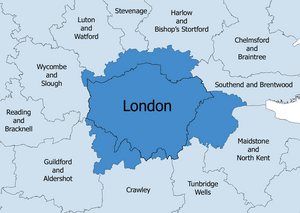London commuter belt
The London commuter belt is that vague region surrounding London and its metropolitan growth from which it is practical to commute daily to work in the capital.
The London commuter belt is a matter of practical application and not boundaries; what is and is not a convenient daily commute will change as transport routes by rail or road are expanded or contracted, or according to the effort a commuter is prepared to expend in getting to work in London rather than seeking a more local job. A village on a railway line may be a commuter town and thus part of "the London commuter belt" while a village closer to London but less easy to get out of may be outside it. The edge of the commuter belt has expanded over time by a general improvement in transport and the larger amount of affordable housing further away from London.[1]
Generally speaking, the commuter belt is considered currently to cover much of the South East; the Home Counties of Middlesex, Surrey, Hertfordshire, Essex, Kent, Berkshire and Buckinghamshire or much of those counties, and indeed parts of Hampshire, Bedfordshire, and Sussex.
Contents
The nature of the commuter belt
Despite the close economic connection with London, the wider commuter belt seeks to avoid becoming like it; indeed one of the major reasons for commuting is to avoid living in the urban environment, although the very popularity of the commuter belt towns has increased the pressure to build more houses on their green acres.
Much of the undeveloped part of the commute belt area lies within the designated Metropolitan Green Belt. The Green Belt perforce excludes the metropolitan conurbation itself but currently covers nearly all of the rest of Surrey, eastern Berkshire, southern Buckinghamshire, southern and mid Hertfordshire, southern Bedfordshire, parts of southern Essex, and of western Kent. In addition, three Areas of Outstanding Natural Beauty the Chiltern Hills, Surrey Hills and North Downs AONBs surrounding the Thames basin feature in the commuter belt.
"Travel to Work Area"
The London Travel to Work Area, defined by the Office for National Statistics as the area for which "of the resident economically active population, at least 75% actually work in the area, and also, that of everyone working in the area, at least 75% actually live in the area."[2] has a population of 9,294,800 (2005 estimate).[3]
See also
Outside links
- London Travel to Work Area mapped with others
- A list of towns considered part of the commuter belt according to World Gazetteer
References
- ↑ BBC News - The new commuter belt. 18 July 2006.
- ↑ Travel to Work Areas (TTWAs) Beginners' guide to UK geography, Office for National Statistics
- ↑ State of the Cities Database Report on the Urban Competitiveness Theme for: - London TTWA (LA) State of the Cities Database - Department for Communities and Local Government (Mid year population estimates on page 4 of the report)
